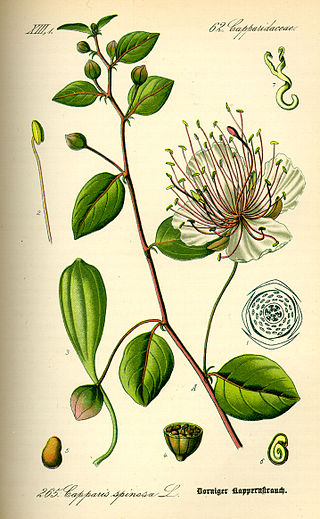
Capparis spinosa, the caper bush, also called Flinders rose, is a perennial plant that bears rounded, fleshy leaves and large white to pinkish-white flowers.

Fontainea is a genus constituting part of the plant family Euphorbiaceae. The nine currently known species grow naturally in Queensland (Qld) and New South Wales (NSW) Australia, New Caledonia and Vanuatu, and Papua New Guinea. Some species are commonly named blushwood.

Commersonia is a genus of twenty-five species of flowering plants in the family Malvaceae. Plants in this genus are shrubs or trees, occurring from Indochina to Australia and have stems, leaves and flowers covered with star-like hairs. The leaves are simple, often with irregularly-toothed edges, the flowers bisexual with five sepals, five petals and five stamens and the fruit a capsule with five valves. The genus underwent a revision in 2011 and some species were separated from Commersonia, others were added from Rulingia.

The Capparaceae, commonly known as the caper family, are a family of plants in the order Brassicales. As currently circumscribed, the family contains 15 genera and about 430 species. The largest genera are Capparis, Morisonia, Maerua, Boscia, and Cadaba.

The wild orange is an Australian native plant found in dry inland areas of Australia. Its scientific name is Capparis mitchellii. It is not related to oranges, nor to the Osage-orange which is known as "wild orange" in North America, but to capers.
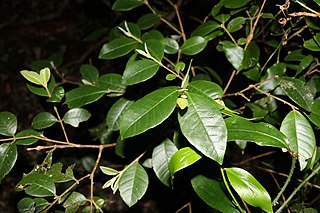
Lenwebbia is a genus of shrubs or small trees in the myrtle family Myrtaceae. The type species is Lenwebbia lasioclada.

Capparis is a genus of flowering plants in the family Capparaceae. It includes 142 species of shrubs or lianas which are collectively known as caper shrubs or caperbushes. Capparis species occur over a wide range of habitat in the subtropical and tropical regions of Africa, Eurasia, Australasia, and the Pacific.

Rhodomyrtus is a group of shrubs and trees in the family Myrtaceae, described as a genus in 1841 and native to southern China, the Indian subcontinent, Southeast Asia, Melanesia, and Australia.

Gossia bidwillii, known as the python tree is a rainforest myrtle of eastern Australia. The usual habitat is the drier rainforest areas. The range of natural distribution is from the Hunter River in New South Wales to Coen in far northern Queensland.

Gossia is a genus of rainforest trees in the myrtle family first described as a genus in 2003 by Neil Snow, Gordon Guymer and Sawvel. It is native to northeastern Australia as well as several islands of Papuasia and New Caledonia.
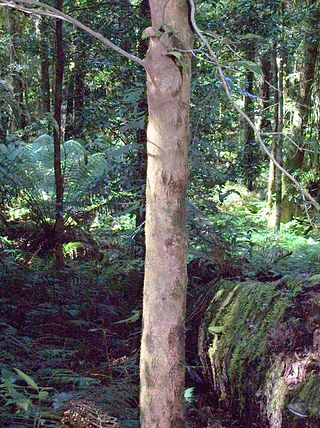
Gossia acmenoides, known as the scrub ironwood, is a rainforest tree of the family Myrtaceae, native to eastern Australia. The usual habitat of this small tree is drier rainforest areas. The range of natural distribution is from Jamberoo in New South Wales to Eungella National Park in northern Queensland.
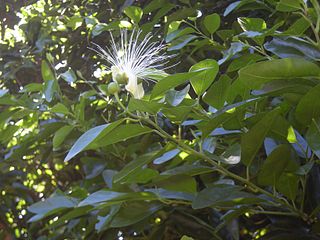
Capparis arborea is a bush or small tree occurring in eastern Australia. Its habitat is rainforest, usually riverine, littoral or the drier rainforests. It is distributed from the Hunter River, New South Wales to Cape Melville in tropical Queensland. Common names include native pomegranate, wild lime, wild lemon and brush caper berry. Capparis arborea is a host plant for the caper white , which migrate across the eastern seaboard in large numbers in the summer. It also feeds the chalky white

Rhodamnia whiteana, known as the cliff malletwood or White's malletwood is a sub-tropical rainforest plant of eastern Australia. It was first formally described in 1986 by Gordon Guymer and Laurence Jessup from a specimen collected from Mount Cordeaux.
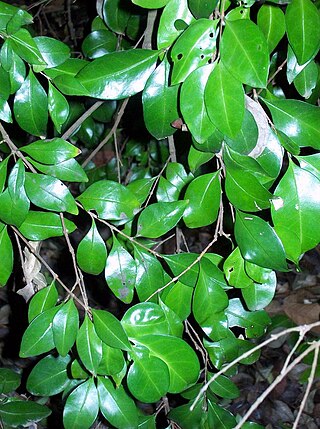
Gossia fragrantissima, the sweet myrtle or small-leaved myrtle, is a shrub or small tree of eastern Australia. A plant with a ROTAP rating of 3EC-, endangered by extinction.

Capparis lasiantha is an endemic Australian plant with a range that extends from the Kimberley region through the Northern Territory and Queensland to northern New South Wales, primarily in drier inland areas although the species extends to the coast in Central Queensland. Common names are numerous and include wyjeelah, nepine, split jack, nipang creeper, nipan, native orange and bush caper.

Notelaea lloydii, commonly known as Lloyd's olive, or Loyd's native olive, is a species of flowering plant in the family Oleaceae and is endemic to Queensland. It is a shrub with leathery, linear or slightly sickle-shaped leaves, pale yellow or cream-colored flowers with 4-lobed petals, 2 stamens and a glabrous ovary. The fruit is a dark blue drupe.

Durringtonia is a monotypic genus of flowering plants in the family Rubiaceae. The genus contains only one species, viz. Durringtonia paludosa, which is endemic to Australia.

Capparis loranthifolia, also known as the narrowleaf bumble or narrow-leaved bumble tree, is a shrub or small tree in the caper family. It is endemic to the arid and semi-arid interior of northern and eastern Australia from Western Australia to New South Wales.

Capparis lucida, commonly referred to as the coast caper, is a versatile plant that often grows as a small tree or a shrub, usually reaching heights of 3 to 4 meters. While it may sometimes climb, it typically produces flowers and fruits as a shrub. The leaves are glossy and range from 3 to 10 cm long and 2 to 5 cm wide, with a noticeable central vein and smaller veins forming loops near the edges. Both the petioles and twigs are covered in fine, soft hairs.

Backhousia kingii is a species of Myrtaceae endemic to Queensland, which was first described in 1988 by Gordon Guymer.




















